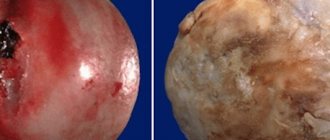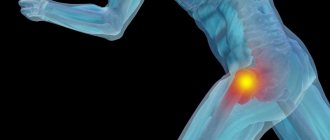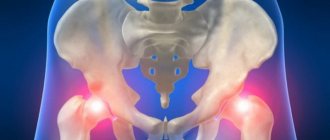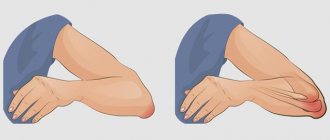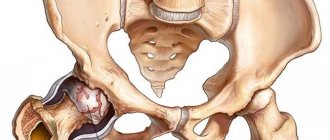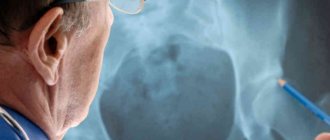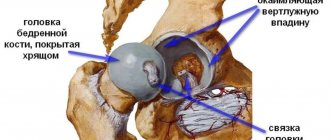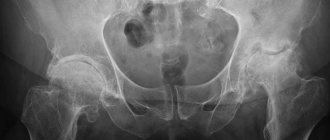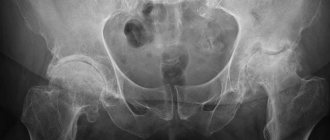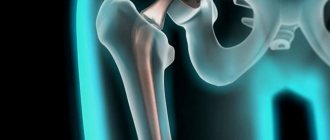Arthritis of the hip joint (coxitis) is an articular pathology that is characterized by activation of the inflammatory process in the cavity of the corresponding joint of various origins. The etiological basis is inflammatory lesions of the hip joint of infectious, autoimmune, traumatic origin, etc. The disease can affect one or both hip joints. Inflammation initially begins in the synovial membrane, and in the final stages it spreads to cartilaginous, ligamentous, and bone tissues. The course of coxitis is quite variable: acute, subacute, and chronic variants are observed.
Diagnosis by X-ray.
Arthritis of any etiology in the largest, functionally significant joint brings a lot of suffering and trials, provoking excruciating pain, stiffness, and impaired mobility. A disease that lasts a long time and/or with frequent relapses, in most cases leads to persistent chronicity of the process, serious complications, in particular to the destruction of all structural elements of the joint, gross deformation of the bone joint. The most severe type, which with inadequate treatment literally leads to disability within 2 years from the onset of symptoms, is rheumatoid arthritis (RA). RA is a most insidious systemic disease, from which it is impossible to completely recover.
Arthritis pathologies of the hip joint have become so firmly established in modern society that they can rightfully be called the epidemic of the century. According to official data, hip arthritis is diagnosed in people of all ages: the elderly, young, teenagers and even children. Statistics show that women suffer from the disease 2-2.5 times more often than men. The peak incidence falls in the age range of 30-55 years. The average age of patients is 47 years. As for the statistics of the total number of patients with this diagnosis, official data is so far only announced for rheumatoid arthritis. Namely: today in Russia, 2 million people suffer from RA of all types and localizations, of which approximately 35% of patients have an unfavorable focus in the hip joints.
Removed femoral head affected by arthritis.
Experts emphasize that there are approximately the same number of registered patients with rheumoatritis of the hip joint and other forms of coxitis as those who do not go to medical institutions for diagnosis and treatment. Moreover, in just 10 years, the number of people with arthritis of the hip joints has almost doubled. An incredibly rapid growth trend in incidence is predicted for the next decade, and experts do not rule out even worse results.
Doctors urge you not to try to treat arthritic pathogenesis on your own. This is a complex, multifactorial inflammation of the most massive and loaded joint of the musculoskeletal system, difficult to treat. Self-medication will not bring any good, but will only worsen the problem. Forecasts directly depend on the timeliness of visiting a doctor, correct diagnosis and a competent, qualified approach to treatment, based on the principle of individuality. Otherwise, the risks of significant or complete loss of movement in the hip joint, serious health problems (infectious-toxic shock, sepsis in advanced infectious forms, severe cardiac and pulmonary damage in RA, etc.), and in some cases even death, are too high.
Minimally invasive endoprosthetics in the Czech Republic: doctors, rehabilitation, terms and prices.
Find out more
General information about the disease
Arthritis of the hip joint (coxitis) is a polyetiological disease in the development of which many factors take part. There are several clinical forms of the disease, during which there are both similar and different symptoms. ICD-10 code M00 – M99.
The hip joint (HJ) is formed by the acetabulum of the pelvic bone and the head of the femur. The spherical shape makes it mobile; a ligament fits from the head of the femur to the acetabulum, holding the articular parts in a normal position. Externally, the hip joint is also strengthened by ligaments and a thick layer of soft tissue. This is the leading supporting joint, located deep in the tissues, so it is not so easy to identify a slow inflammatory process with mild symptoms in it.
Arthritis of the hip joint develops at any age, since the disease can have different origins. The most relevant clinical forms are lesions in childhood and adolescence, as well as tuberculous arthritis.
Causes
The etiology of arthritis of the hip joint is very different. A special group of diseases consists of lesions of various origins in childhood and adolescence. They are united under the common name “juvenile idiopathic arthritis” (JIA), where the term “idiopittic” means unspecified origin. This includes both truly unspecified arthritis and rheumatoid, psoriatic and other arthritis in children under 16 years of age. Very often at this age the disease occurs with the development of hip arthritis.
Another reason for the development of hip arthritis is a specific infection - tuberculosis, gonorrhea, syphilis, brucellosis. Infectious hip arthritis in adults most often develops with gonorrhea, in children and adolescents - with tuberculosis.
Nonspecific infection (mostly coccal) can also cause arthritis of the hip joint. The inflammatory process usually develops against the background of open injuries during wounds, surgical interventions and intra-articular manipulations. The process often becomes purulent and requires surgical treatment.
In rheumatoid arthritis, coxitis rarely develops, but it is often one of the symptoms of ankylosing spondylitis, an autoimmune disease that affects the spine and large joints.
Quite often, the cause of the development of hip arthritis is chronic intestinal diseases and some other diseases of the internal organs. Reactive hip arthritis is quite rare.
Read more about which joints are affected by reactive arthritis here.
Very often, patients with coxitis have a hereditary burden - close relatives suffering from similar diseases. Triggering factors for the onset of the disease are: past infections, hypothermia, stress, heavy physical activity, bad habits.
Symptoms of hip arthritis
Arthritis of the hip joint can be acute or chronic. The main manifestations of the disease will be different. It is worth knowing these manifestations in order to consult a doctor in a timely manner.
Joint pain and inability to stand on your leg are some of the first symptoms of hip arthritis
First signs
Symptoms of arthritis of the hip joint in the acute course of the disease: high body temperature, chills, malaise, joint pain, inability to stand on the leg due to pain. The symptoms are characteristic, so the diagnosis is usually not in doubt.
The signs of chronic hip arthritis are difficult to notice. It begins unnoticed with slight pain when moving, morning stiffness, which quickly passes. Sometimes pain appears when the leg is in a certain position, for example, when straightening. Special attention should be paid to such vague symptoms.
Obvious symptoms
In acute hip arthritis, this is increasing joint pain and fever that lasts more than 5 days. This usually indicates the development of a suppurative process.
But more often, hip arthritis develops gradually and the obvious symptoms are a slow increase in stiffness and pain. Since the patient begins to spare his leg, he develops muscle atrophy, the diseased leg becomes thinner than the healthy one, and gait and posture are disturbed. It will be easier to bend your leg at the hip than to straighten it.
Dangerous symptoms
If these symptoms appear, you should immediately consult a doctor:
- pain accompanied by high fever after injury, surgery or manipulation of the hip joint;
- the appearance of joint pain 1 to 4 weeks after the infection;
- pain in the hip joint is accompanied by morning stiffness of movement.
Pelvic pain in pregnant women
There are several reasons why hip joints may hurt in women:
- in recent weeks - lack of calcium or vitamin D;
- increased production of the hormone relaxin, which promotes sprains;
- exacerbation of latent hip dysplasia or osteoarthritis;
- increased stress on the joint due to weight gain;
- old injury.
Women who have pelvic pain during pregnancy should be more attentive to their health, because this condition can lead to an exacerbation of even minor diseases.
Why is hip arthritis dangerous?
The hip joint is the largest joint in the body. It is the support of the human body. However, arthritis of the hip joint often goes unnoticed and leads to disability. The stages of the inflammatory process transform into one another and along with them the function of the hip joint is gradually lost. Therefore, during examination and diagnosis, the stage of the disease, possible complications and the tendency to relapse are identified.
Stages of hip arthritis
According to the degree of activity of the inflammatory process and its progression, there are 3 stages of arthritis of the hip joint:
- Initial
– inflammation of the synovial membrane, increased content of inflammatory exudate. At this stage, the restriction of movement is insignificant and occurs mainly due to pain and muscle spasm. On ultrasound, you can see an increased volume of exudate in the joint capsule. - Expanded
. The degree of inflammation activity is high, and the first signs of a destructive process in the hip joint also appear. An X-ray can show narrowing of the joint space and bone loss (osteoporosis), and an MRI can show erosive damage to the cartilage tissue covering the articular surface. The pain is constant, movements are limited, mainly when extending the leg and turning it inward (rotation). - Advanced
- formation of immobility (ankylosis). The bone tissue of the joint grows and fusion occurs into a single conglomerate. Often this fusion occurs in an incorrect position, which seriously limits movement. Complete disability occurs.
Possible complications
Arthritis of the hip joint can be complicated by:
- abscesses and fistulas (breakthrough of purulent exudate to the surface of the body) - with purulent and tuberculous hip arthritis;
- complete immobility of the joint;
- dislocations and subluxations of the hip joint;
- deformation of the entire skeleton against the background of pronounced changes in the hip joint.
To prevent this from happening, you should consult a specialist at the first signs of hip arthritis.
What to do if the disease relapses
Healthy and arthritic hip joint
Some clinical forms of this pathology occur in waves, with exacerbations and remissions. Exacerbations are rarely pronounced, but are still accompanied by pain. To eliminate pain before consulting a doctor, you can take the following measures:
- take any sedative (calming) agent - tincture of valerian or motherwort, Corvalol, etc.;
- take a tablet of medication from the group of NSAIDs (non-steroidal anti-inflammatory drugs) - Diclofenac, Nise, Indomethacin, etc.;
- apply ointment, gel or cream with NSAIDs to the skin over the sore spot (Voltaren, Pentalgin);
- call a doctor at home;
- lie down and take the least painful position.
The most common clinical forms of coxitis
Depending on the cause of occurrence, hip arthritis can have a different course. Symptoms of the disease may also vary slightly.
Any form of arthritis has serious complications, so you should not delay treatment.
See how easily the disease can be cured in 10-12 sessions.
Acute purulent coxitis
The hip joint is protected from external influences by a thick layer of soft tissue, so infection enters it mainly during injuries and surgical procedures. Much less often, it enters with blood from other infectious and inflammatory foci, for example, with sinusitis, otitis, tonsillitis, etc.
A sign of purulent arthritis is a sharp rise in body temperature, chills, malaise combined with severe joint pain. Such a patient requires emergency surgical care. If it is not provided, the purulent process can spread to the surrounding soft tissues with the formation of abscesses and phlegmons or with blood flow throughout the body (sepsis).
Juvenile idiopathic arthritis (JIA)
Juvenile idiopathic arthritis occurs mainly in children under 16 years of age
This is a large group of diseases that includes all hip arthritis in children and adolescents under the age of 16. It is not always possible to determine the origin (etiology) of this disease. The disease is dangerous because it can quickly lead to complete destruction of the hip joint and early disability.
The disease arises and proceeds unnoticed with a gradual increase in pain and loss of normal function. Quite quickly, the affected leg loses volume and begins to look thinner in appearance. Bone growth also lags behind, one limb becomes shorter than the other. It is difficult for the child to straighten the leg and especially turn the knee inward. Identifying JIA at an early stage and carrying out adequate therapy prescribed by a rheumatologist allows you to avoid disability.
Tuberculous coxitis
Tuberculous arthritis of the hip joint is a severe progressive disease. The source of infection first forms in the bone tissue and only after some time breaks into the joint cavity. Tuberculous arthritis of the hip joint occurs in three stages:
- Prearthritic
- the tuberculous focus is located inside the joint-forming bones, most often in the area of the acetabulum of the pelvic bone. It proceeds unnoticed in the form of minor pain and periodically developing lameness. At this stage, coxitis is rarely detected. - Arthritic
associated with the breakthrough of a tuberculosis focus into the joint cavity:- beginning - the pain intensifies, the tissues swell, the skin turns red; impaired movement due to muscle spasms; low-grade fever, weakness, lack of appetite;
- height – inflammation progresses, cartilage is destroyed; the pain is very strong, inflammation increases, gait is disturbed, it is difficult to stand on the leg, it moves with difficulty; intoxication increases;
- subsidence of the process - inflammation gradually subsides, connective tissue grows in the articular cavity.
- Postarthritis
- inflammation goes away, but its consequences remain in the form of shortening of the limb, muscle atrophy and incorrect placement of the limb, as a result of which the configuration of the whole body can change. Ankylosis is most often connective tissue, but bone ankylosis also occurs. Disability.
Chondroprotectors: what are they, how to choose, how effective are they?
Joint pain at rest
Coxitis in chronic inflammatory bowel lesions
Arthritis of the hip joint often begins against the background of chronic ulcerative colitis and Crohn's disease (a pathological process affecting all layers of the intestinal wall). The disease begins suddenly, accompanied by severe inflammation and joint pain. It lasts for several months, then the process subsides without causing any changes in the joint. Relapses of the disease are also possible.
Symptoms
Symptoms of the disease appear gradually. In the early stages, the patient experiences pain at the time of maximum physical exertion. The rest of the time, the injured tendon does not cause any discomfort to the child or adult. Over time, the pain syndrome becomes more intense: discomfort occurs with minimal physical activity. If left untreated, the patient may be unable to perform everyday activities such as washing dishes, putting on clothes, fastening buttons, tying shoelaces.
The skin next to the source of inflammation turns red and swelling forms. Local temperatures may rise. Palpation of the tendon increases the pain. With sudden movements of the injured limb, the patient may hear a crunching or crackling sound.
Diagnostics
To identify symptoms of hip arthritis and its treatment, special questionnaires have been developed for patients, clinical tests for specialists, and various laboratory and instrumental studies. It is not easy to detect this disease at an early stage, but it is most treatable when it starts. Algorithm for examining a patient with suspected coxitis:
- Laboratory methods:
- general, biochemical, immunological blood tests
- the degree of activity of the inflammatory process and the presence of autoimmune processes are revealed; - examination of intra-articular fluid under a microscope and by inoculating on nutrient media
- the nature of the inflammatory process, infection and its sensitivity to antibiotics are revealed. - Instrumental methods:
- Ultrasound
- you can detect a large volume of exudate and an increase in the synovium; - radiography of the hip joint
- bone changes in the joint; - MRI or CT
– changes in articular and periarticular tissues; - arthroscopy
– examination of the inner surface of the joint cavity; if necessary, exudate or a piece of tissue is taken for examination; - aspiration biopsy of the joint
- sampling of exudate for examination using a puncture method (if arthroscopy is not possible).
A full examination can only be carried out in a clinic.
Orthopedics and traumatology services at CELT
The administration of CELT JSC regularly updates the price list posted on the clinic’s website. However, in order to avoid possible misunderstandings, we ask you to clarify the cost of services by phone: +7
| Service name | Price in rubles |
| Appointment with a surgical doctor (primary, for complex programs) | 3 000 |
| X-ray of the hip joint | 2 400 |
| MRI of hip joints (2 joints) | 8 000 |
All services
Make an appointment through the application or by calling +7 +7 We work every day:
- Monday—Friday: 8.00—20.00
- Saturday: 8.00–18.00
- Sunday is a day off
The nearest metro and MCC stations to the clinic:
- Highway of Enthusiasts or Perovo
- Partisan
- Enthusiast Highway
Driving directions
Treatment of hip arthritis
Treatment measures can be conservative or surgical. The main goal of treating hip arthritis is to relieve pain and suppress the progression of the disease. The patient is prescribed individually selected complex treatment.
Drug therapy
Treatment of hip arthritis begins with drug therapy. All medications are selected individually for each patient:
- NSAIDs in the form of injections, tablets for oral administration, external agents (gels, ointments, creams); Diclofenac is recognized as the most effective drug in this group, but it often gives complications from the gastrointestinal tract, so some patients are more suitable for modern drugs in this group, for example, Nise; ointments and creams based on NSAIDs have virtually no side effects;
Crunching in joints - when to worry
Intra-articular injections of hyaluronic acid
Non-drug methods
These treatments for hip arthritis include:
- Immobilization is carried out mainly for tuberculous coxitis and ankylosing spondylitis at the stage of acute inflammatory process. A large coxite plaster cast is applied, covering the affected leg, pelvic girdle and torso to the nipples. When the process subsides, the bandage is replaced with crutches and the load on the leg is gradually increased by incorporating therapeutic exercises.
- Massage – performed after acute inflammation subsides, helps improve blood circulation, activate metabolism and restore joint function.
- Therapeutic exercise (physical therapy) - for some types of hip arthritis, especially in childhood and adolescence, exercise therapy is prescribed as early as possible - this prevents the development of ankylosis. The load should be constant and gradually increasing. Monitoring by a doctor is required.
- Physiotherapeutic procedures - different types of procedures can be prescribed at any stage. At the acute stage, this is electrophoresis with anti-inflammatory and painkillers; when the process subsides, UHF, paraffin, laser and magnetic therapy.
- Reflexology is an effect on points on the human body reflexively associated with the hip joint.
- Sanatorium-resort treatment is carried out in a state of remission, no earlier than six months after the last exacerbation. Resorts shown:
- with sodium chloride waters and mud - Anapa, Pyatigorsk, Evpatoria;
- with hydrogen sulfide waters - Sochi-Matsesta;
- with radon waters - Belokurikha, Tskhaltubo.
Traditional methods of treatment
Traditional medicine can be used as an auxiliary therapy for hip arthritis only as directed and under the supervision of a physician. For swelling and joint pain, the following folk remedies are suitable:
- decoction of bay tree leaves; 20 g of crushed raw materials pour 500 ml of hot water, boil over low heat for 5 minutes, cool, strain and take 150 ml three times a day before meals; has anti-inflammatory and analgesic effects; course – 3 days with a week break, then repeat everything;
- ointment for joint pain; mix the yolk of a chicken egg, 20 ml each of apple cider vinegar and turpentine; store in the refrigerator and use as a pain reliever, applying to the skin over the sore spot at night.
Read more about the most effective methods of treating arthritis in this article.
Surgical methods of treatment
In severe cases of arthritis of the hip joint, endoprosthetics is performed
Surgical assistance is required for purulent hip arthritis. Punctures are performed, pus is removed from the joint cavity, then it is washed with an aseptic solution. When abscesses and phlegmons appear, they are opened and the pus is removed. In case of significant destruction of the hip joint, especially in cases of trauma, resection of the most affected bone areas is performed.
In case of complete loss of joint function, the operation of choice is endoprosthetics - replacement of the destroyed joint with an artificial implant.
Prevention
You can reduce the risk of inflammation of the joint capsule or the development of relapses using preventive measures. Effective:
- Moderate physical activity.
- A balanced diet so that the cartilage tissue receives all the necessary nutrients.
- Maintaining a normal weight - every extra kilogram increases the load on the spine and joints.
- Maintaining immunity by such methods as a daily routine, adequate sleep and rest, a balanced diet, walks in the fresh air and other measures.
- Wearing comfortable orthopedic shoes, maintaining posture.
Approach to treating the disease at the Paramita clinic, Moscow
Patients with suspected hip arthritis are always carefully examined by specialists at our clinic using modern laboratory and instrumental methods, including MRI. During the examination, the main and concomitant diseases are identified and only after that individually selected treatment is prescribed.
Our doctors are trained in all existing methods of treating this disease. The Western techniques they use allow them to act directly on the source of inflammation, while the Eastern ones – on the body as a whole, restoring the proper functioning of all organs and systems, including the hip joint.
This approach to treatment allows you to quickly eliminate the pain syndrome and stimulate the patient’s desire for recovery. Then the main course of treatment is carried out, aimed at suppressing inflammation and progression of the disease. The final stage is the restoration of lost joint function. Treatment allows patients to forget about pain and lead a normal life. More information about treatment methods for hip arthritis can be found on our website.
We combine proven techniques of the East and innovative methods of Western medicine.
Read more about our unique method of treating arthritis
General clinical recommendations
To avoid relapses of hip arthritis and forget about pain, patients are recommended to:
- lead an active healthy lifestyle;
- Healthy food;
- get rid of excess weight and bad habits - smoking and alcohol abuse;
- do exercise therapy every day; Swimming is especially beneficial;
- avoid heavy physical activity, hypothermia and stress;
- carefully treat all acute and chronic diseases;
- take courses of anti-relapse therapy several times a year as prescribed by a doctor.
How not to get sick
The hip joints should be especially taken care of by persons with a family history and who have relatives with a similar pathology. To do this, you need to avoid any factors that provoke the disease: infections, hypothermia, stress. It is also necessary to move more, engage in feasible sports to strengthen the muscles of the back and lower extremities, and also maintain normal body weight.
What to eat
Meals should be varied and regular. It is worth limiting: spicy seasonings, fried, fatty, smoked foods, alcohol, sweets - all this can provoke inflammatory processes in the joints.
Our doctors
Poltavsky Dmitry Ilyich
Traumatologist-orthopedist
Experience 28 years
Make an appointment
Zubikov Vladimir Sergeevich
Traumatologist-orthopedist, Doctor of Medical Sciences, doctor of the highest category, professor
44 years of experience
Make an appointment
Marina Vitaly Semenovich
Traumatologist-orthopedist, head of the minimally invasive traumatology and orthopedics service
Experience 36 years
Make an appointment
Samilenko Igor Grigorievich
Traumatologist - orthopedist, doctor of the highest category
24 years of experience
Make an appointment
Frequently asked questions about the disease
Which doctor should I contact?
It’s better to start with a therapist, he will advise who to contact. A surgeon treats purulent processes, a rheumatologist - everything else, except for tuberculosis, you need to contact a phthisiatrician.
Can juvenile arthritis be cured without surgery?
With adequate treatment, you can get rid of relapses of the disease and its progression. Modern methods of conservative treatment allow patients to forget about exacerbations forever during maintenance treatment. Surgery is a last resort, but sometimes it is still necessary.
Literature:
- Yablokova E. A. Clinical features and impaired mineralization of bone tissue in children with inflammatory bowel diseases. Diss. Ph.D. honey. Sci. M., 2006. 185.
- Dzyuba G.G., Reznik L.B., Erofeev S.A., Stasenko I.V. Modern methods of treating surgical infection of the hip joint // Modern problems of science and education. – 2021. – No. 5.
- D'Incà R., Podswiadek M., Ferronato A., Punzi L., Salvagnini M., Sturniolo GC Articular manifestation in inflammatory bowel disease patients. A prospective study // Dig Liver Dis. 2009, Mar 9.
- Rodriguez VE, Costas PJ, Vazquez M., Alvarez G., Perez-Kraft G., Climent C., Nazario CM Prevalence of spondyloarthropathy in Puerto Rican patients with inflammatory bowel disease/Ethn Dis. 2008, Spring; 18(2 Suppl 2):S2–225–9.
Themes
Arthritis, Joints, Pain, Treatment without surgery Date of publication: 12/09/2020 Date of update: 03/12/2021
Reader rating
Rating: 5 / 5 (2)
